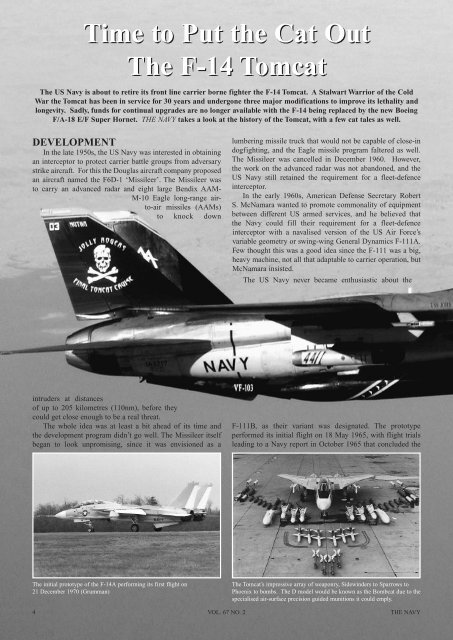Time to Put the Cat Out<strong>The</strong> F-14 Tomcat<strong>The</strong> US <strong>Navy</strong> is about to retire its front line carrier borne fighter the F-14 Tomcat. A Stalwart Warrior <strong>of</strong> the ColdWar the Tomcat has been in service for 30 years and undergone three major modifications to improve its lethality andlongevity. Sadly, funds for continual upgrades are no longer available with the F-14 being replaced by the new BoeingF/A-18 E/F Super Hornet. THE NAVY takes a look at the history <strong>of</strong> the Tomcat, with a few cat tales as well.DEVELOPMENTIn the late 1950s, the US <strong>Navy</strong> was interested in obtainingan interceptor to protect carrier battle groups from adversarystrike aircraft. For this the Douglas aircraft company proposedan aircraft named the F6D-1 ‘Missileer’. <strong>The</strong> Missileer wasto carry an advanced radar and eight large Bendix AAM-M-10 Eagle long-range airto-airmissiles (AAMs)to knock downlumbering missile truck that would not be capable <strong>of</strong> close-indogfighting, and the Eagle missile program faltered as well.<strong>The</strong> Missileer was cancelled in December 1960. However,the work on the advanced radar was not abandoned, and theUS <strong>Navy</strong> still retained the requirement for a fleet-defenceinterceptor.In the early 1960s, American Defense Secretary RobertS. McNamara wanted to promote commonality <strong>of</strong> equipmentbetween different US armed services, and he believed thatthe <strong>Navy</strong> could fill their requirement for a fleet-defenceinterceptor with a navalised version <strong>of</strong> the US Air Force’svariable geometry or swing-wing General Dynamics F-111A.Few thought this was a good idea since the F-111 was a big,heavy machine, not all that adaptable to carrier operation, butMcNamara insisted.<strong>The</strong> US <strong>Navy</strong> never became enthusiastic about theintruders at distances<strong>of</strong> up to 205 kilometres (110nm), before theycould get close enough to be a real threat.<strong>The</strong> whole idea was at least a bit ahead <strong>of</strong> its time andthe development program didn’t go well. <strong>The</strong> Missileer itselfbegan to look unpromising, since it was envisioned as aF-111B, as their variant was designated. <strong>The</strong> prototypeperformed its initial flight on 18 May 1965, with flight trialsleading to a <strong>Navy</strong> report in October 1965 that concluded the<strong>The</strong> initial prototype <strong>of</strong> the F-14A performing its first flight on21 December 1970 (Grumman)<strong>The</strong> Tomcat’s impressive array <strong>of</strong> weaponry, Sidewinders to Sparrows toPhoenix to bombs. <strong>The</strong> D model would be known as the Bombcat due to thespecialised air-surface precision guided munitions it could emply.4 VOL. <strong>67</strong> NO. 2 THE NAVY
Two <strong>of</strong> the Tomcat’s air-air weapons. From top to bottom; the AIM-9LSidewinder heat-seeking AAM on a side mounting <strong>of</strong>f the main under wingpylon and a AIM-7 Sparrow semi-active radar homing AAM.<strong>The</strong> heart <strong>of</strong> the Tomcat arsenal, the AIM-54 Phoenix AAM. <strong>The</strong> Tomcatcould carry six Phoenix which could be used to engage six targetssimultaneously at 100nm (185km) and in fire-and-forget mode.F-111B was highly unsatisfactory. Attempts were made t<strong>of</strong>ix the problems, but it was impossible. Congress cut fundsin May 1968, work was halted in July, and the program wasformally axed in December, after the construction <strong>of</strong> a total <strong>of</strong>seven F-111B prototypes and evaluation aircraft.<strong>The</strong> Grumman company had actuallybeen responsible fordevelopingthe F-111B as a subcontractor for GeneralDynamics. In January 1966, following the highlynegative US <strong>Navy</strong> report on the F-111B, at the <strong>Navy</strong>’srequest Grumman began work on a set <strong>of</strong> designs for amore effective carrier-based interceptor, with the companydesignation <strong>of</strong> G-303, derived from their F-111B work.Grumman submitted their finalist proposals to the <strong>Navy</strong> inOctober 19<strong>67</strong>.In July 1968, when the F-111B was clearly dead, theUS <strong>Navy</strong> began a new competition for a fleet defenceinterceptor under the VFX program. Grumman submitted theG-303 against proposals from <strong>No</strong>rth American, LTV, GeneralDynamics, and McDonnell Douglas. Grumman, which tendedto have a leg up in any competition for the <strong>Navy</strong> as thecompany had been supplying excellent aircraft to the servicefor decades, won the award in January 1969. <strong>The</strong> projectwas assigned high priority. <strong>The</strong> <strong>Navy</strong> was worried about newSoviet threat aircraft like the MiG-25 ‘Foxbat’, and the longdelays in fielding an improved fighter that piled up from thecancelled Missileer and F-111B programs left the admiralsvery worried.<strong>Navy</strong> <strong>of</strong>ficials inspected a mockup <strong>of</strong> the definitive G-303concept in the spring <strong>of</strong> 1969. Although some <strong>of</strong> the earlierconcepts had featured fixed wings, the mockup used swingwings.An initial development contract for six prototype andevaluation YF-14A Tomcats, as the type was designated, wasawarded to Grumman that same year. Incidentally, the nameTomcat was selected partly to pay tribute to <strong>Navy</strong> AdmiralsThomas Connolly and Thomas Moorer. Connolly was such astrong supporter <strong>of</strong> the program that the aircraft was referredto as Tom’s Cat, and the name stuck. <strong>The</strong> contractwas later modified to fund twelve YF-14As.<strong>The</strong> initial prototype F-14A performedits first flight on 21 December1970. Initial deliveriesAn F-14D Tomcat <strong>of</strong> VF-103‘<strong>The</strong> Jolly Rogers’ <strong>of</strong>f theUSS JOHN F. KENNDEY on their final deployment. (USN)<strong>of</strong> production Tomcats to the <strong>Navy</strong> took place in October1972, with the aircraft arriving at Naval Air Station (NAS)Miramar in California. <strong>The</strong> Tomcat entered operationalservice with <strong>Navy</strong> fighter squadrons VF-1 and VF-2 on boardthe carrier USS ENTERPRISE in September 1974. <strong>The</strong>US <strong>Navy</strong> eventually acquired 478 F-14As, including the 12development aircraft, with the type replacing the McDonnellDouglas F-4 Phantom and Vought F-8 Crusader in US <strong>Navy</strong>service.THE F-14A<strong>The</strong> F-14A is a big aircraft, with tandem seating for a pilotin front and Radar Intercept Officer (RIO) in back both onMartin-Baker GRU-7A ‘zero-zero (zero speed, zero altitude)’ejection seats. <strong>The</strong> cockpit layouts are specialized for the pilotand RIO, and have little duplication.<strong>The</strong> variable-geometry wing scheme incorporates anumber <strong>of</strong> advanced features. One is the fit <strong>of</strong> glove vanes,small triangular foreplanes mounted in the wing gloves thatare automatically extended at high speeds as the main wingsare swept back, compensating for any change in aircraft pitchcaused by the change in wing geometry.<strong>The</strong> wing sweep is controlled by a Mach sweep programmerthat automatically moves the wings through the range <strong>of</strong> 20THE NAVY VOL. <strong>67</strong> NO. 2 5

















